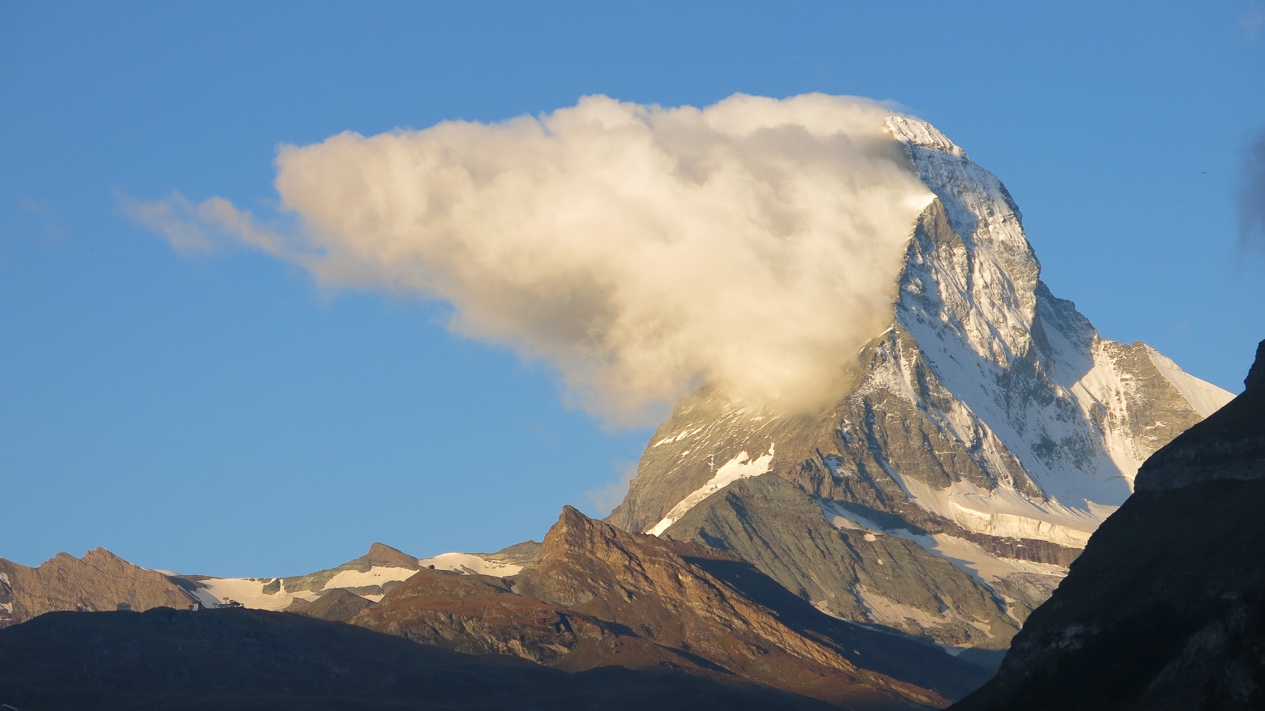Banner clouds
Banner clouds are clouds which appear to be attached to the leeward side of a steep mountain or a ridge. They are generally highly turbulent and they often appear to be like a banner attached to the mountain, which explains their name. Below you see a photograph of a banner cloud at Mt Matterhorn, taken by my former graduate student I. Prestel; the wind in this photograph is blowing from the right, so quite apparently the cloud is on the leeward side of the mountain.
 Banner cloud at Mt. Matterhorn
Banner cloud at Mt. Matterhorn
Some time ago we started to observe banner clouds with the help of time lapse movies taken by a simple webcam which was positioned at the observatory at the top of mount Zugspitze (Schween et al. 2007). These movies, in combination with further measurements, revealed numerous properties of banner clouds at this mountain (Wirth et al. 2012).
Our main activity is to investigate banner clouds using numerical simulations. It turned out that banner clouds are formed in an ascending branch of air in the lee of the mountain (Reinert et al. 2007, Reinert and Wirth 2009) and that this requires parcel trajectories to first go around the mountain before they are lifted (Schappert and Wirth 2015). Other mechanisms which have been suggested as an explanation for banner clouds are less likely to be relevant (Voigt and Wirth 2013). The situation which is most conducive to banner cloud formation requires a steep mountain and weak stratification of the air (Prestel and Wirth 2016).


Simulation of flow over an idealized mountain
A summary text about banner clouds in non-technical language can be found in Wirth (2016).
References
- Prestel, I., and V. Wirth, 2016: What flow conditions are conducive to banner cloud formation? J. Atmos. Sci., 73, 2385-2402. [Link to online version.]
- Reinert, D., J. Eichhorn, W.-G. Panhans, and V. Wirth, 2007: A new LES model for simulating air flow and warm clouds above highly complex terrain. Part I: The dry model. Boundary Layer Meteorology, 125, 109-132, doi: 10.1007/s10,546-007-9183-8.
- Reinert, D., and V. Wirth, 2009: A New Large-Eddy Simulation Model for Simulating Air Flow and Warm Clouds Above Highly Complex Terrain. Part II: The Moist Model and its Application to Banner Clouds. Boundary-Layer Meteorology, 133 113-136.
- Schappert, S., and V. Wirth, 2015: Origin and Flow History of Air Parcels in Orographic Banner Clouds. J. Atmos. Sci., 72, 3389-3403. [Link to online version.]
- Schween, J., J. Kuettner, D. Reinert, J. Reuder, and V. Wirth, 2007: Definition of 'banner clouds' based on time lapse movies. Atmos. Chem. Phys., 7, 2047-2055. [Available online.]
- Voigt, M., and V. Wirth, 2013: Mechanisms of Banner Cloud Formation. J. Atmos. Sci., 70, 3631-3640. [Link to online version.]
- Wirth, V., 2016: Orographische Bannerwolken: Systematische Untersuchungen zu einem faszinierenden Naturphänomen. PROMET, 98, 95-101.
- Wirth, V., M. Kristen, M. Leschner, J. Reuder, and J. H. Schween, 2012: Banner clouds observed at Mount Zugspitze. Atmos. Chem. Phys., 12, 3611-3625. [Available online.]